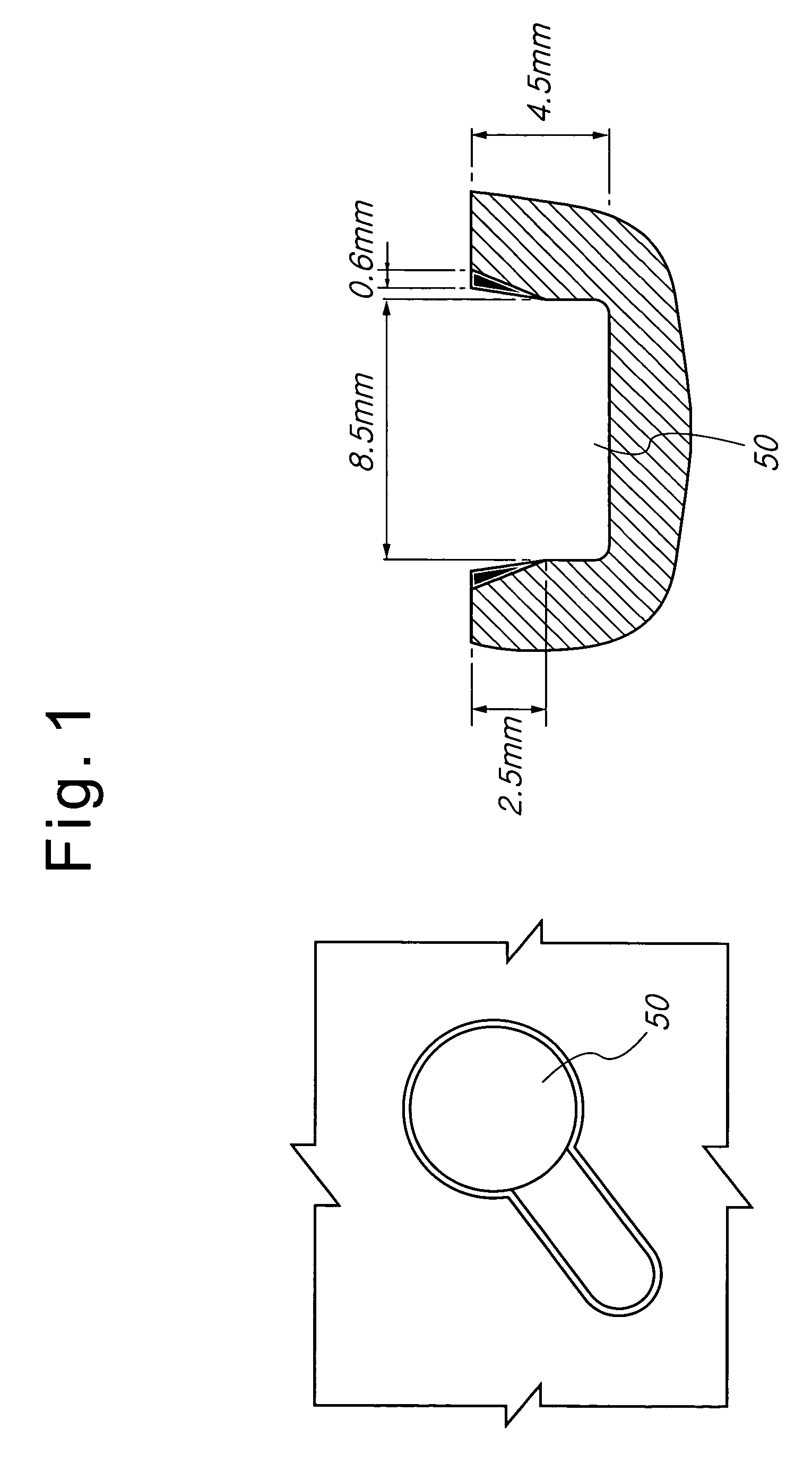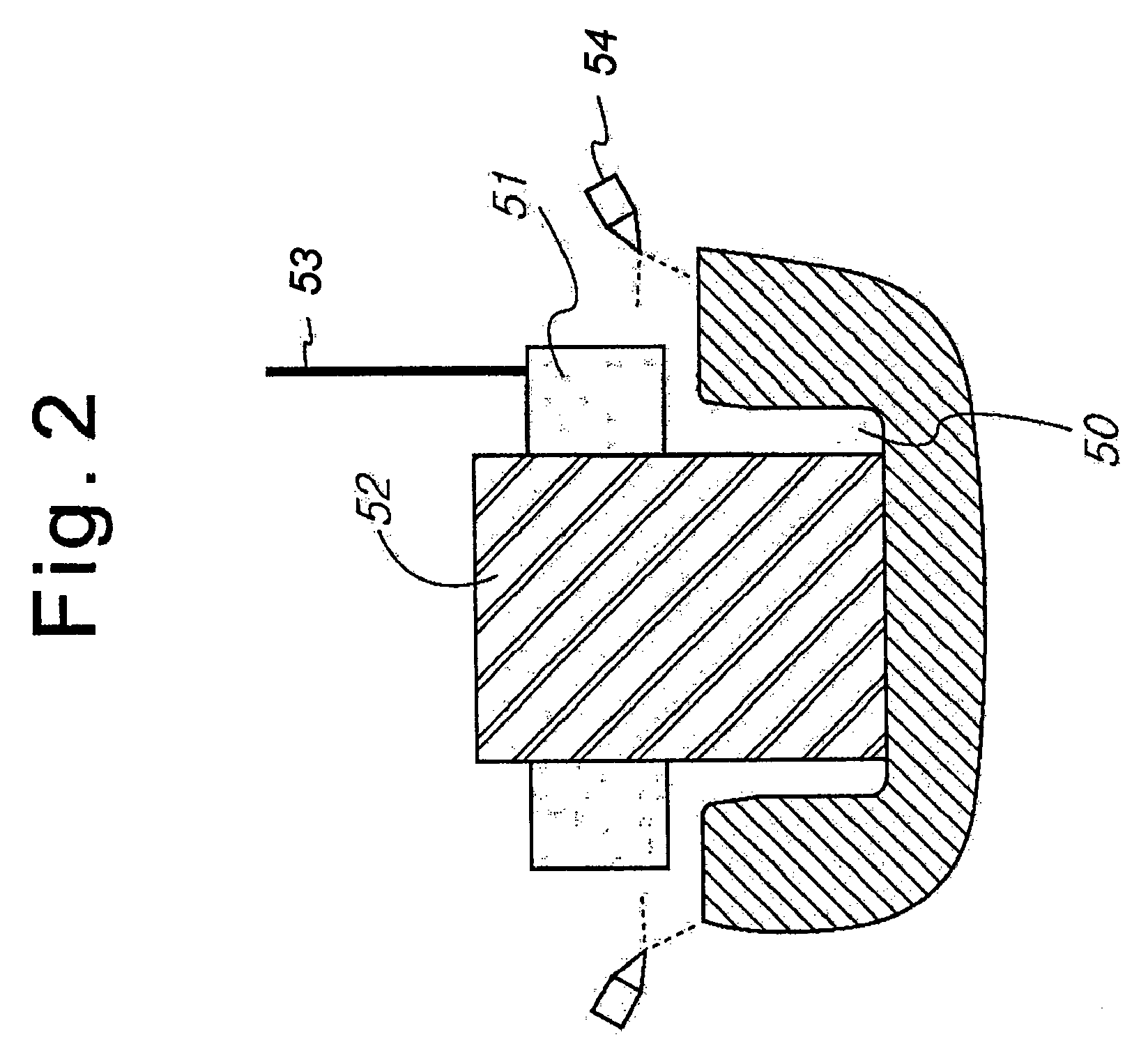High frequency heat treatment method for fine bottom-closed hole
a heat treatment method and heat treatment technology, applied in heat treatment apparatus, electric/magnetic/electromagnetic heating, furnaces, etc., can solve the problems of low operation efficiency, achieve stable high quality, reduce manufacturing costs, and provide wear resistance and stiffness
- Summary
- Abstract
- Description
- Claims
- Application Information
AI Technical Summary
Benefits of technology
Problems solved by technology
Method used
Image
Examples
first embodiment
[0021] high frequency heat treatment is performed using a coil 51 placed above the fine bottom-closed hole 50, and a core 52 for controlling a magnetic flux inserted into a coil 51 such that the core 52 protrudes from upper and lower sides of the coil 51.
[0022]The heat treatment is performed under conditions of a heating time of 2˜3 seconds, an output power of 200˜300 kW, a quenching time of 3˜5 seconds, a voltage of a positive electrode 53 of 4˜8 kV, and a current of the positive electrode of 2.0˜4.5 A.
[0023]After performing the heat treatment under the conditions as described above, a cross-section of the fine bottom-closed hole 50 was observed.
[0024]As a result, the fine bottom-closed hole 50 has a hardening depth of 2.0 mm which is lower than the target hardening depth, 2.5 mm, and a hardening width of 0.6 mm. In addition, a retained austenite structure was observed at the microstructure of the fine bottom-closed hole 50 due to insufficient cooling of a corner of the fine bottom...
second embodiment
[0027] high frequency heat treatment is performed using a coil 51 with a lower portion thereof inserted into the fine bottom-closed hole 50 and an upper portion exposed to an outside, and a core 52 for controlling a magnetic flux placed within the coil 51 such that the core 52 protrudes from upper and lower sides of the coil 51.
[0028]The heat treatment is performed under conditions of a heating time of 2˜3 seconds, an output power of 200˜300 kW, a quenching time of 3˜5 seconds, a voltage of a positive electrode 53 of 4˜8 kV, and a current of the positive electrode of 2.0˜4.5 A.
[0029]After performing the heat treatment under the conditions as described above, a cross-section of the fine bottom-closed hole 50 was observed.
[0030]As a result, the fine bottom-closed hole 50 has a hardening depth of 2.6 mm, and a hardening width of 1.0˜1.4 mm, both of which satisfy the target values. In addition, although a retained austenite structure is also formed at the corner of the product due to de...
third embodiment
[0032]In the third embodiment, high frequency heat treatment is performed using a coil 51 completely inserted into the fine bottom-closed hole 50, and a core 52 for controlling a magnetic flux placed within the coil 51 such that the core 52 protrudes from upper and lower sides of the coil 51.
[0033]In addition, cooling nozzles 54 are disposed around a part to be heat treated such that a sufficient amount of cooling water is injected uniformly over the whole heated part of the fine bottom-closed hole with a sufficient pressure via the cooling nozzles 54 during a quenching step after the heat treatment.
[0034]The heat treatment is performed under conditions of a heating time of 2˜3 seconds, an output power of 200˜300 kW, a quenching time of 3˜5 seconds, a voltage of a positive electrode 53 of 4˜8 kV, and a current of the positive electrode of 2.0˜4.5 A.
[0035]After performing the heat treatment under the conditions as described above, a cross-section of the fine bottom-closed hole 50 was...
PUM
| Property | Measurement | Unit |
|---|---|---|
| positive electrode voltage | aaaaa | aaaaa |
| diameter | aaaaa | aaaaa |
| diameter | aaaaa | aaaaa |
Abstract
Description
Claims
Application Information
 Login to View More
Login to View More - R&D
- Intellectual Property
- Life Sciences
- Materials
- Tech Scout
- Unparalleled Data Quality
- Higher Quality Content
- 60% Fewer Hallucinations
Browse by: Latest US Patents, China's latest patents, Technical Efficacy Thesaurus, Application Domain, Technology Topic, Popular Technical Reports.
© 2025 PatSnap. All rights reserved.Legal|Privacy policy|Modern Slavery Act Transparency Statement|Sitemap|About US| Contact US: help@patsnap.com



